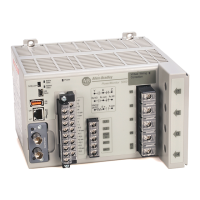Rockwell Automation Publication 1426-UM001J-EN-P - August 2019 463
Appendix G
IEEE 1159 Power Quality Event Classification
Power Quality Event
Classification per
IEEE 1159-2009
IEEE 1159-2009, Recommended Practice for Monitoring Electric Power
Quality, categorizes various power quality events that are based on the parameters
of the event such as voltage change, frequency content, rise time, and event
duration. Table 227
, excerpted from the standard, summarizes the classifications
in the recommended practice, and indicates which PowerMonitor™ 5000 models
support monitoring of each category of phenomena.
IMPORTANT Table 227
is adapted from standard IEEE 1159-2009 and is used with
permission.
Table 227 - Categories and Typical Characteristics of Power System Electromagnetic Phenomena
(1)
Categories Typical Spectral Content Typical Duration Typical Voltage
Magnitude
1426-M6 1426-M8
1.0 Transients •
1.1 Impulsive •
1.1.1 Nanosecond 5 ns rise < 50 ns
1.1.2 Microsecond 1 μs rise 50…1 ms
1.1.3 Millisecond 0.1 ms rise > 1 ms •
1.2 Oscillatory •
1.2.1 Low frequency < 5 kHz 0.3…50 ms 0…4 pu
(2)
•
1.2.2 Medium frequency 5…500 kHz 20 μs 0…8 pu
1.2.3 High frequency 0.5…5 MHz 5 μs 0…4 pu
2.0 Short-duration root-mean-square
(rms) variations
••
2.1 Instantaneous ••
2.1.1 Sag 0.5…30 cycles 0.1…0.9 pu • •
2.1.2 Swell 0.5…30 cycles 1.1…1.8 pu • •
2.2 Momentary ••
2.2.1 Interruption 0.5 cycles - 3 s < 0.1 pu • •
2.2.2 Sag 30 cycles - 3 s 0.1…0.9 pu • •
2.2.3 Swell 30 cycles - 3 s 1.1…1.4 pu • •
2.3 Temporary ••
2.3.1 Interruption >3 s…1 min < 0.1 pu • •
2.3.2 Sag >3 s …1 min 0.1…0.9 pu • •
2.3.3 Swell >3 s…1 min 1.1…1.2 pu • •
3.0 Long duration rms variations ••

